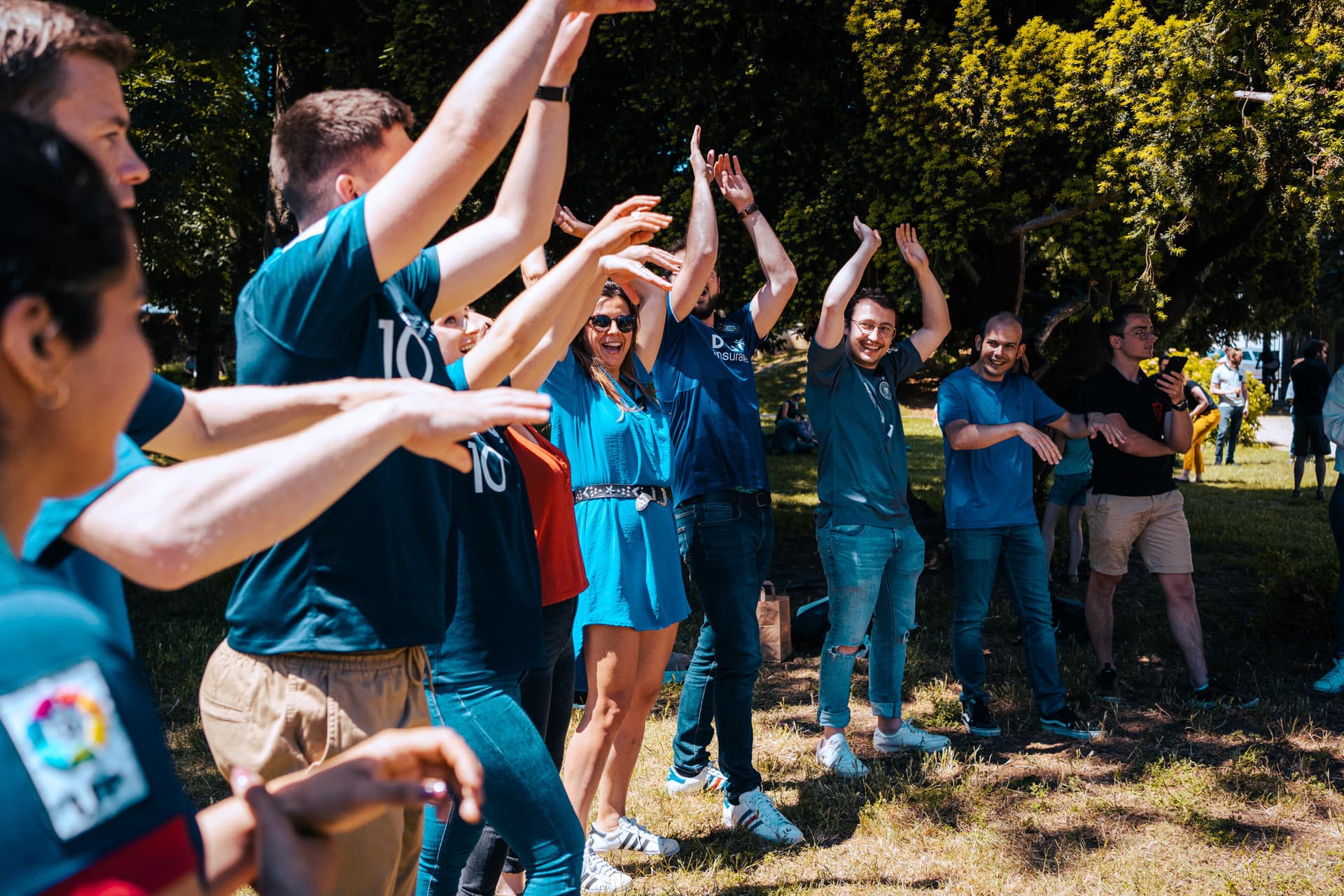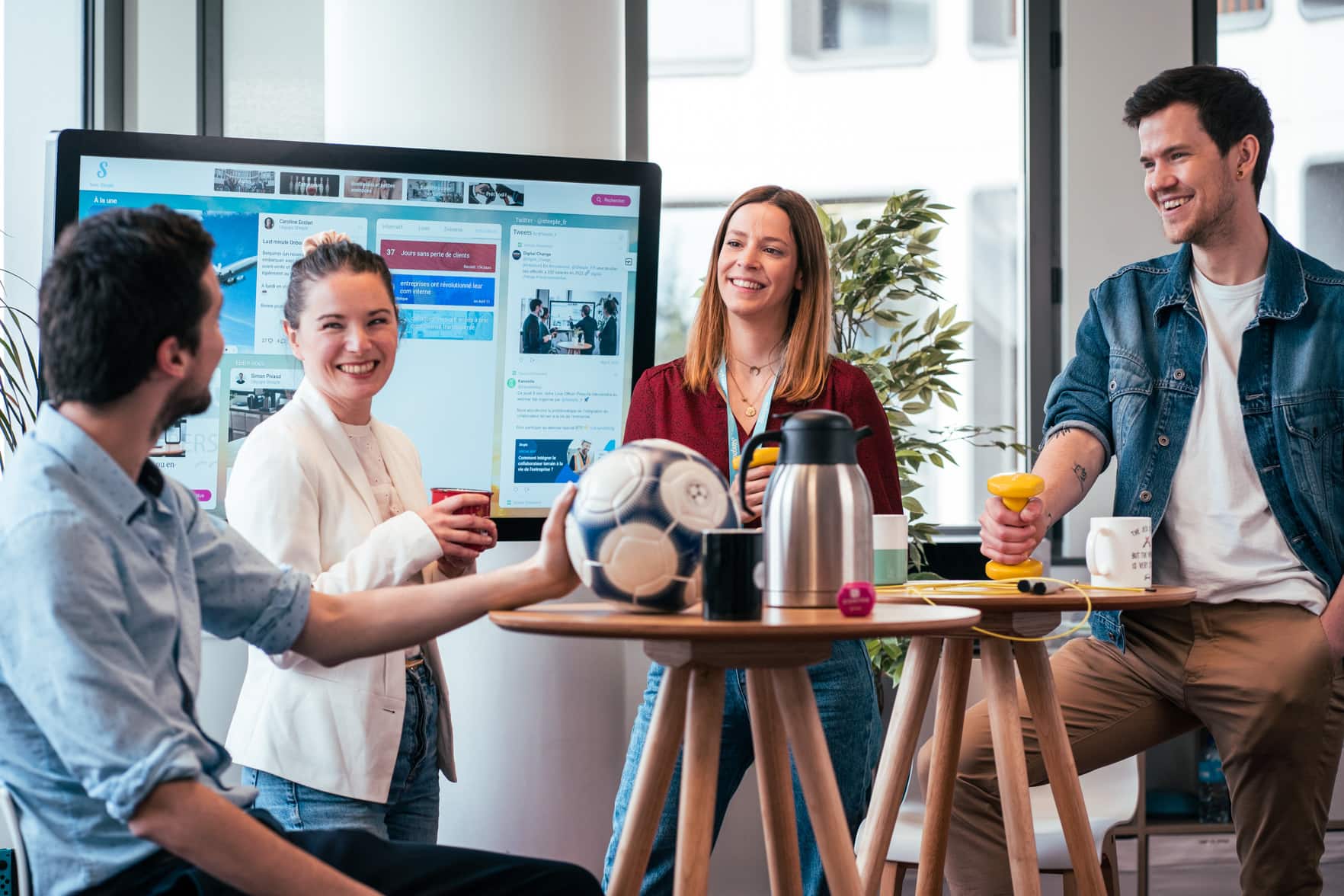Published on 27/05/2024
Companies have now realized that internal communication is not just about newsletters, intranet and top-down communication... In short, it's not just about spreading information !
The human dimension is essential for :
- Federating teams
- Develop a sense of belonging
- Get everyone involved
How can we achieve these 3 objectives ? With an in-house event !
The difference between the ordinary and the extraordinary is that little extra.
Jimmy Johnson, sport coach
It's a fantastic tool for all managers and communicators: the corporate event allows employees to go beyond their individual logic in order to develop a collective vision focused on a common objective.
In-house events are that little extra that makes all the difference and helps to make every employee motivated, involved and enthusiastic: in short, a happy employee !
So how can you be sure of turning an event into a success ? Steeple gives you the keys to a successful in-house event ! 🚀
#1 - Internal event: who organizes it ?
There are plenty of internal events that take place at particular moments in the life of a company, with a variety of objectives :
- An employee's birthday
- Christmas evening
- Team building activities
- Greetings from the management
- Sporting events
- The arrival or departure of a new employee, etc.
Depending on the type of event, but also on the culture and customs within the company, the organizer may be :
- The communications department: usually the events manager or the communications manager
- The Social and Economic Committee (ESC)
- The Human Resources (HR) department
- Management
#2 - What is the organizer's role ?
Working with cross-functional departments, the organizer's role is to draw up the communications operations and design the in-house event from start to finish.
➡️ Define the objective of the internal event
The first essential step to a successful project is to set precise objectives, before determining the right event format. Would you like to :
- Developing corporate culture ?
- Valuing and thanking employees ?
- Boost motivation ?
- Create links and commitment ?
- Inform and train ?
- Reassure teams ?
- Celebrate a success ? etc.
Depending on your objectives, the most appropriate type of event will be different. For example, if you want to strengthen team cohesion, a team building workshop would be appropriate. To develop links between employees in a less formal setting, afterworks or team lunches will be particularly effective.
Nearly one employee in two considers that a seminar is an opportunity to have a good time and meet new colleagues. And 72% of them say that it gives them the opportunity to talk to everyone: in other words, to forge links !
➡️ Thinking about the project in all its dimensions
An in-house event needs to be meticulously prepared : it's a subtle recipe made up of many carefully measured and thought-out ingredients !
Here are some questions to ask yourself :
- Who should be invited to the event ? All the teams ? Managers ? Employees only or spouses as well (for an end-of-year party, for example) ?
- How can employees be involved in the organization? Can they participate, or even co-construct the event ?
- What format should I choose ? Lunch, dinner, full day, etc.?
- When will it take place ? During working hours or outside working hours (evenings, weekends) ?
- Where (type of location, travel times for employees) ?
- What and how ? Brainstorming, conferences, workshops or relaxing activities (cultural, sporting, festive...)
- What’s the budget ?
- Implementation: do we need a dedicated presenter, a common theme, signage, etc. ?
- Is participation compulsory or not ?
#3 - How to communicate effectively about your in-house event ?
As with any event project, good communication is one of the pillars of success. Every stage counts: from promotion upstream to sharing memories after the event and communication at the time, it's vital to leave nothing to chance.
Here are the 4 essential phases of the communication plan for your internal even :
➡️ Probe
Often overlooked, this step is vital if you want to avoid a major flop !
By surveying out employees and listening to their needs and desires, you can better meet their expectations. Take advantage of this phase to encourage everyone's creativity, by allowing them to make suggestions.
A survey conducted by Cap'Com has shown that :
A participative management, consulting employees beforehand about their expectations and needs, and involving them in the content are the keys to a successful event.
This can be done informally with a sample of people over a coffee or in the break room, or formally, as part of a survey of all teams.
For example, the Survey module in the Steeple tool is a practical way of gathering employee opinions in a very short space of time. This module allows them to become more involved in the life of the company and allows you to improve and better understand their needs.
➡️ Advertise
To get employees excited, create a buzz around the forthcoming event :
- Publicize the event in the in-house newsletter
- Send personal invitations
- Distribute an "event publication" on your internal communication tool
- Tell a little, but don't tell everything... Let the mystery unfold!
And if you're using Steeple, take advantage of the Countdown module to create a sense of anticipation !
➡️ Cover
Good coverage of the event means that employees can be kept informed in real time about how the day is going, so that everything runs smoothly.
There are several ways of doing this :
- Perfectly designed signage
- A program distributed to each participant via a publication
- Regular information from the host, etc....
➡️ Saying thank you and taking stock
Communication doesn't stop once the event is over: to make sure it leaves a positive impression, thank all the teams for their participation and involvement :
- Ask participants for feedback at the end of the event
- Send them the materials for the various events
- Share photos and videos with them
- Sometimes, some participants take the lead and give you feedback on the event
Bring this event to life throughout the year by sharing photos, videos or a photo slideshow with employees.
They'll appreciate the idea, and they'll reminisce about the good times and shared memories, which will reinforce their sense of belonging.
On the other hand, they will continue to discuss it at formal occasions such as meetings or over the coffee machine.
#4 - How do you measure the success of an internal event ?
Finally, as with any communications operation and any project in general, it is essential to analyze the results in order to identify both the successes and the areas for improvement :
➡️ Participation rates
For non-mandatory internal events, observe the participation rate, for example by looking at the number of participants who completed the survey :
- Is it important ?
- Is it the same in all departments and for all types of position ?
- Are certain categories of employee under-represented ? If so, why ?
➡️ Team involvement
Analyze team involvement on the day of the event. This will be all the easier if, on the day, you have put in place activities whose results can be quantified.
For example, by organizing a vote via your internal communications tool or by rallying employees around a hashtag.
➡️ Participants' feelings
Gather feedback from participants : ask for their opinion via a survey or a more in-depth internal survey. For example, you can easily create a free survey using Google form and distribute it to participants.
You now have all the keys you need to turn an in-house event into a success. Now get to work! Do you want to communicate about in-house events? Download our guide to the top 10 corporate events :
Do you want to improve your internal communications? Let's discuss your project together and find out how Steeple is improving the working lives of over 250,000 employees.
Foire aux questions
Internal communication defines the flow of information exchanged between members of a company, an association or a local authority. Long underestimated, internal communication now plays a fundamental role in the smooth running and growth of companies. In particular, it strengthens the corporate culture and the commitment of your employees...
Internal corporate communication is important for :
- increase employee commitment
- improve the quality of life at work
- strengthen corporate culture.
Effective in-house communication translates into employee loyalty, a successful recruitment process and fluid management. These are just some of the ways in which you can attract talent to all your departments and set yourself apart from the competition.
Internal corporate communication is not easy: information is not always shared at the right time, is not accessible to the whole company or is not distributed to the right people. An effective in-house communication tool can help to :
- facilitate exchanges between employees
- automate your communication plan
- distribute information to all your employees, even those who are offline.
But you still need to choose the right tool...
About the author
Steeple Team
Chargée de contenus
Read all the articles from the Steeple team, the experts in internal communication and employee experience.
-1.png)











